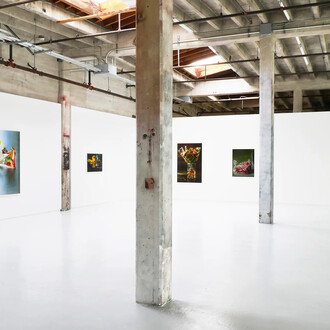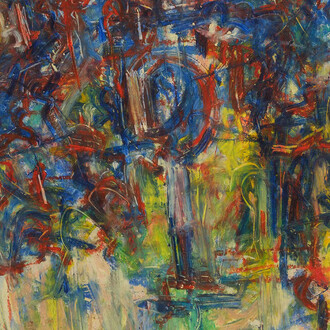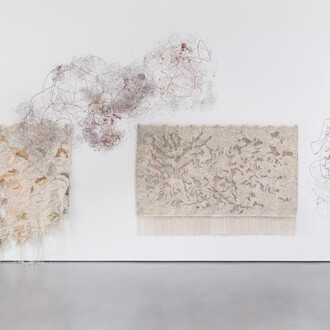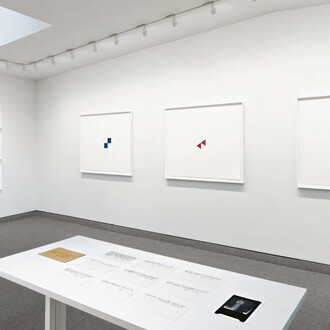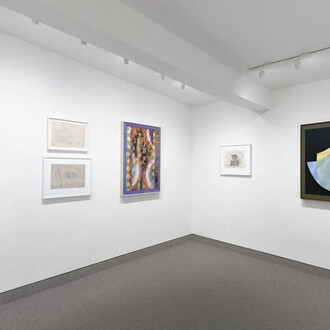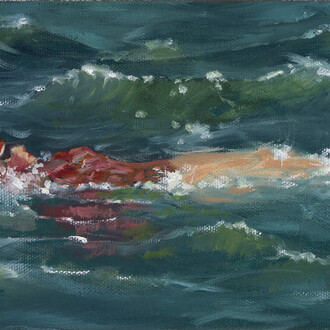Rod Barton is pleased to present ‘Rope Burn: Painting Behind the Velveteen Curtain’, an exhibition featuring works by an international group of emerging artists: Maiken Bent, Alfred Boman, Alex Da Corte, Parker Ito, and Roman Liška.
The artists joined together in this exhibition share a common sensibility regarding image-making rooted in the aesthetics of contemporary consumer culture. Key to this process is the notion of a remediation of content and material - be it in the quoting of tribal-tattoo-like shapes in Alfred Boman‘s frivolously colorful paintings, the visually chaotic and camp digital collages of Parker Ito, shrill patterning in the modified readymade sculpture by Roman Liška, Maiken Bent´s secretly kinky assemblages, or the integration of a fellow contemporary artist‘s work in Alex Da Corte‘s installation on view. The shared concerns with contemporary culture and its overdetermined aesthetic, perhaps as an attempt at salvaging what has become a primary source of inspiration to all of these young artists, appears to have been the driving force for the production of the mongrels on display, which are neither paintings nor sculptures proper. The speculative appropriation of imagery, shapes, and attitudes originally located in a particular cultural sphere and temporality gets dislocated, taken out of context, mashed up with other stylistic elements of varying origins, and thus allows for a fresh view on these formerly marginal aesthetic languages that have gained traction in the discourse around contemporary art and culture once again.
In Alex Da Corte ́s `Velveteen (Wilson Kelvin McQuade) ́ the viewer finds a painting by fellow artist Kyle Thurman incorporated as part of a meta-installation, which further includes an arrangement of eight copies of Janet Jackson ́s `The Velvet Rope´ cd jewel case, mounted via display brackets onto a metal grid, which, in turn, is painted with enamel matching the tonality of the aforementioned painting. The title of this work refers in part to the 1998 music-video `You´ by Janet Jackson that incorporates live footage from a concert in Glasgow during the `The Velvet Rope Tour´, including a split-second scene in which the then sixteen-year-old concert attendee Wilson Kelvin McQuade receives a lap dance from the singer who was then performing the eponymous song `Rope Burn´ in the live concert from which the footage was originally recorded. The analogy which offers itself up here in a lap dance performed by one artwork for another may be crass, yet too fitting to be ignored: the two components are literally rubbing up against each other, hung intimately side by side. The dense web of references conjured by Da Corte‘s suggestive titles, which inevitably become part of the artwork itself, are first and foremost a device to examine the behavior of objects within networks of meaning, and in turn the representation of events calcified within objects. No longer synonymous only with a flat picture plane hung on the wall, today, painting tends to emphasize the apparatus of its appearance and the conduits of its circulation. With this in mind the concept of transitive painting as described by David Joselit is indexical of the final stage in the transformation of painting from the representational via abstraction to networked incarnation: What defines transitive painting [...] is its capacity to hold in suspension the passages internal to the canvas, and those external to it .́
The notion of Networked Painting is continued in Roman Liška’s sculptural object ‘untitled (Stokke Tripp Trapp bleu)’ on display: Tripp Trapp, the Danish design-furniture company Stokke’s children’s chair is covered in a craquelure technique that has most recently been resurrected by Blue-Chip artist Anselm Reyle in a contemporary form, including neon coloring in a body of work which in turn resembles the ‘combine paintings’, coined by Robert Rauschenberg in the late fifties, that integrated objects onto a canvas or flat surface to create a relief-like assemblage. In front of the backdrop of Liška’s previous, tastefully understated Financial Times series, which explored an over-identification with the implied values of post-industrial wealth creation, the application of this decidedly vulgar combination composed of neon-color and cracked-surface coating resembling a case-modder´s wet dream, then applied to a mundane design object such as a children’s chair, sits somewhere in between persiflage and travesty, when we come to consider Reyle´s status as the epitomy of the sub-prime art bubble, which stubbornly refuses to burst, yet. Poised between acerbic critique and detached commentary, reading the work through the expanded field of these references allows the viewer to draw from the context worked into the object itself, which perhaps points toward the vacuity of objecthood within contemporary art in general, and specifically painting´s prominent role of complicity in this development.
In contrast, ‘Maiken Bent can hardly be said to be a painter.’ This claim introduces the artists work in an essay titled ‘Transcendental Abstraction’. Of course, this statement immediately places the discussion around, if not within the discourse of painting. Her delicately sensual objects speak of passion, pleasure and pain: Reflecting upon fetishism as a desire, in which pain and pleasure interweave, her series innocently titled Dreamcatchers (2011) features hanging, surreal torture objects consisting of an interlace of golden chains, jewels and ropes. Looking closer at the sculptures, one would notice a large handcuff-type ring here and whip-like sticks there, barely noticeable. Bent seems to operate an aesthetization of sex in bright colors, somewhere between Gucci and fetish-wear, luxury and the hardcore. The viewer can observe this haptic sensibility while also not loosing track of the meta-narrative that unfolds amongst these seductive objects: Bent’s work presents a particular perspective on issues of gender by questioning a certain definition of feminine art. [...] Bent, however, plays against stereotypes, incorporating found material often dug out from hardware stores or fishermen supplies, such as rope, feathers or chains, into her craft. The objects on display refuse a defined classification, but rather sit comfortably in the cracks of their inherent contradictions.
Meanwhile, the digital collages delivered as prints by Parker Ito seem to pursue an agenda of equalizing images in what could be described as a kind of reverse iconoclasm. The contrasting imagery, eclectic in its appearance yet carefully chosen, levels out the aesthetic sphere in which these disparate images come to coexist. The Internet as a primary source for material to manipulate is more a means than an end, perhaps mainly chosen for its convenience. In his work on view (Untitled) we see hyper-real 3D renderings of metal chains, overlaid by doodles of an obscure nature, while at the same time these elements of composition are formally held together by what appears to be a grid-like pattern, a variation of tartan maybe. The conversation here is most certainly one around the agency of images and, ex negativo, the loss thereof. In the works of Parker Ito, we find him to push against questions of gesture and transmission, aesthetic theatricality, myths surrounding meaning, image as artifact, the efficacy of expression through media and how painting navigates technology. The work on view is both digitally UV-printed and screen-printed directly onto a 3M Scotchlite reflective fabric, and then sealed by stretching a transparent vinyl on top of it, giving the surface a glossy and superflat quality.
Alfred Boman on the other hand relies entirely on analog methods to construct his abstract compositions. The vibrant colors and dazzling shapes are as animated as painting gets. For him there is no holding back in what the artist refers to as post-digital painting. His take on abstraction is clearly informed by a wide field of visual influences including videogame aesthetics and sci-fi/fantasy, amateur-painting as well as psychedelia and rave culture. The sensibility evidenced in the visual translation of cultural awareness manifests itself into a refreshing take on Painting Travesty, in which titles such as `Dragon Dandruff´, `Glutamat´, or `Sea Weed Panic´ point towards the character of persiflage, rather than painting with a capital P. Speed, repetition and travesty itself are the prime components of this mode of operation according to David Joselit who makes a convincing case for his proposal when he quotes painter Amy Sillman as follows: I don´t find it odd that AbEx practices have now been vitally reinvigorated by a queered connection of the vulgar and the camp. ´ The reorientation of potential readings achieved by these strategies allows for a reintegration of what seemed to be dated codes of communication from decades past-infusing them with new meaning and, hence, a refreshed potential for being read in front of a backdrop of the contemporary discourse around painting furthered by this group of exciting artists.
Rod Barton Gallery
One Paget Street
London EC1V 7PA United Kingdom
Ph. +44 (0)20 72783259
info@rodbarton.com
www.rodbarton.com
Opening hours
Thursday - Saturday
From 2pm to 6pm or by appointment





